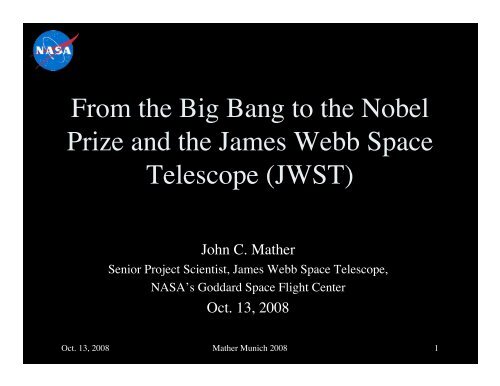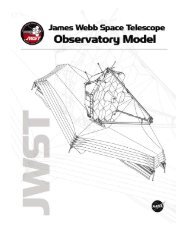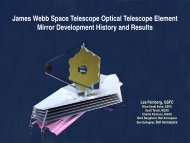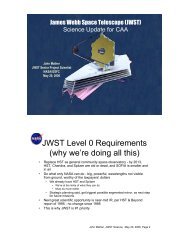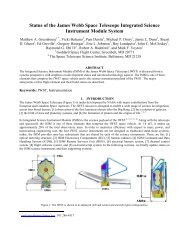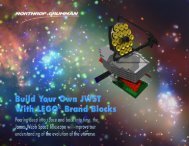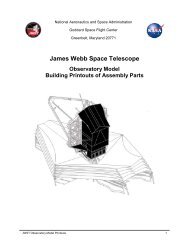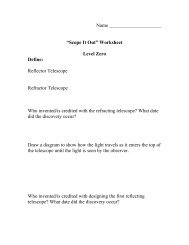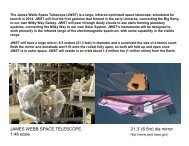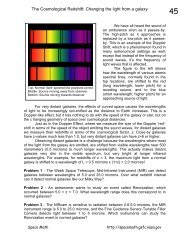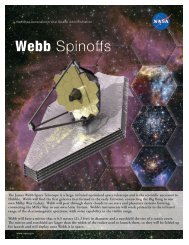4.2 MB pdf - James Webb Space Telescope - NASA
4.2 MB pdf - James Webb Space Telescope - NASA
4.2 MB pdf - James Webb Space Telescope - NASA
You also want an ePaper? Increase the reach of your titles
YUMPU automatically turns print PDFs into web optimized ePapers that Google loves.
From the Big Bang to the NobelPrize and the <strong>James</strong> <strong>Webb</strong> <strong>Space</strong><strong>Telescope</strong> (JWST)John C. MatherSenior Project Scientist, <strong>James</strong> <strong>Webb</strong> <strong>Space</strong> <strong>Telescope</strong>,<strong>NASA</strong>’s Goddard <strong>Space</strong> Flight CenterOct. 13, 2008Oct. 13, 2008 Mather Munich 2008 1
Rutgers Lusscroft Farm - Site ofEarly Nerds in Sussex County, NJOct. 13, 2008 Mather Munich 2008 2
Astronomical Search For OriginsFirst GalaxiesBig BangGalaxies EvolveLifePlanetsStarsOct. 13, 2008 Mather Munich 20083
Can you imagine?Your chin is madeof exploded stars!Oct. 13, 2008 Mather Munich 2008 4
Looking Back in TimeOct. 13, 2008 Mather Munich 20085
Measuring DistanceThis techniqueenablesmeasurement ofenormous distancesOct. 13, 2008 Mather Munich 20086
Astronomer's Toolbox #2:Doppler Shift - LightAtoms emit light at discretewavelengths that can be seenwith a spectroscopeThis “line spectrum” identifiesthe atom and its velocityOct. 13, 2008 Mather Munich 20087
Hubble’s Law - 1929 DiscoverySpeed proportional to distanceAge = distance/speedSpeed -->Distance -->Oct. 13, 2008 Mather Munich 2008 8
The Power of ThoughtAlexander FriedmanGeorges Lemaître & Albert EinsteinGeorge GamowRobert Herman & Ralph Alpher Rashid Sunyaev Jim PeeblesOct. 13, 2008 Mather Munich 2008 9
Oct. 13, 2008 Mather Munich 2008 10
Big Bang - Cosmic Explosion 13.7billion years agoIMPOSSIBLE TODRAW A PICTURE!Oct. 13, 2008 Mather Munich 2008 11
So what happened?• Primordial material, possibly infinite in everydimension• Small piece of it (10 cm in size?) doessomething quantum mechanical with unknownphysics• Rapid expansion, faster than light can keep upwith, stretches this little bit into wholeobservable universe (cosmic inflation)Oct. 13, 2008 Mather Munich 2008 12
How did the whole observableuniverse fit into that little ball?• <strong>Space</strong> is mostly empty - stars are very very farapart• Atoms are mostly empty - atomic nuclei are verytiny compared to size of atoms• Squeeze very hard, and compression can createantimatter and rip quarks apart inside protons andneutrons• Squeeze even harder, and the known laws ofphysics no longer apply - space and time may mixinto higher dimensions?Oct. 13, 2008 Mather Munich 2008 13
How did a smooth Big Bangmake complicated things like us?• Gravity is long range attractive force– Matter distribution is unstable• Remove heat, and system heats up more• Makes condensed objects (stars, galaxies, etc.)• Gravitational energy flows support complexity• Stars release heat from nuclear reactions– Heat & light received by Earth supportcomplexity, from weather to photosynthesisOct. 13, 2008 Mather Munich 2008 14
Brief History of the UniverseBig Bangseen byCOBE &WMAP?Galaxyassembly?Galaxies,stars,planets,life• Horrendous <strong>Space</strong> Kablooey - exponential expansion, primordial fluctuations,matter/antimatter, dark matter, dark energy, 13.7 ± 0.2 billion years ago• Annihilation of antiparticles, 1 part per billion matter remaining• Formation of Helium nuclei, 3 minutes, redshift z = 10 9– [1+z = size of universe now / size then]• Formation of neutral gas “recombination”, 389,000 yrs, z=1089• Population III supermassive stars, super-supernovae, and black holes, z=17(age ~ 200 Myr)• Galaxy formation in small parts, star formation, merging and clustering ofgalaxy parts, until z~1• Expanding universe begins to accelerate, 5 billion years ago• Earth and Sun form, 4.5 billion years ago• Mammals dominant, ~ 55 million years ago• Humans, lions, tigers, mammoths, 1-2 million years ago• <strong>Telescope</strong>s, Galileo, 1609: ~ 400 yr• Theory of Special Relativity, 100 yr• <strong>NASA</strong> founded, Oct. 1, 1958• Signs of life on other planets …?• Far future: we’re toast (1 billion yrs)• Andromeda Nebula collides with Milky Way (5 billion years)• Sun goes out (7.6 billion years)• Universe continues to expand faster, we lose sight of other galaxies• Universe goes dark?Oct. 13, 2008 Mather Munich 200815
COBE in orbit,1989-1994Oct. 13, 2008 Mather Munich 2008 16
Based on 9 minutes of dataPresented at AmericanAstronomical Society, January 1990Oct. 13, 2008 Mather Munich 2008 17
Sky map from DMR,2.7 K +/- 0.003 KDoppler Effect of Sun’smotion removed (v/c = 0.001)Cosmic temperature/densityvariations at 389,000 years, +/-0.00003 K (part in 100,000)Oct. 13, 2008 Mather Munich 2008 18
Nobel Prize Press ReleaseThe Royal Swedish Academy of Sciences hasdecided to award the Nobel Prize in Physicsfor 2006 jointly to John C. Mather, <strong>NASA</strong>Goddard <strong>Space</strong> Flight Center, Greenbelt,MD, USA, and George F. Smoot,University of California, Berkeley, CA,USA "for their discovery of the blackbodyform and anisotropy of the cosmicmicrowave background radiation".Oct. 13, 2008 Mather Munich 2008 19
From Press Conference toStockholmOct. 13, 2008 Mather Munich 2008 20
Oct. 13, 2008 Mather Munich 200821
Dark Energy!MacArthur Fellow2008 - Adam RiessOct. 13, 2008 Mather Munich 200822
A few big mysteries…• Why is there matter and no antimatter?• What is dark matter?• What is dark energy?• Was Einstein right about relativity?• How did we get here?– Formation of stars, chemical elements, galaxies, planets, …• Are we alone?– How did Earth become habitable?– Any other places that could support life?• What happens next?Oct. 13, 2008 Mather Munich 200823
Light comes in more colors than our eyes can seeLight from the first galaxies is redshifted from thevisible into the infrared.Infrared is heatradiationOur eyes can’t seeit, but our skincan feel itOct. 13, 2008 Mather Munich 200824
JWST Orbits the Sun-Earth Lagrange Point L2L1-3, Leonhard Euler, 1750.L4 & 5, Joseph-LouisLagrange, 1772Oct. 13, 2008 Mather Munich 200826
Model PictureOct. 13, 2008 Mather Munich 2008 27Full scale model at GSFC
JWST Deployment videoOct. 13, 2008 Mather Munich 2008 28
JWST TechnologyBackplaneMirror PhasingAlgorithmsNear-Infrared DetectorBeryllium PrimaryMirror SegmentμShuttersMid-Infrared DetectorCryocoolerCryogenic ASICsSunshield MembraneOct. 13, 2008 Mather Munich 2008 29
Testbed <strong>Telescope</strong>• 1/6 scale model with all the sameadjustments• Proves that all the adjustmentprocedures work as expectedOct. 13, 2008 Mather Munich 2008 30
Four science instruments enable imagery and spectroscopyover the 0.6 – 29 micron spectrumNIRSpecNIRCamFGSMIRI15 May 2008 Presentation to Rebka Conference: U. Wyoming31
JWST cold optical test in HoustonOct. 13, 2008 Mather Munich 200832
End of the dark ages: firstlight?S. Beckwith andHUDF team , 2004Oct. 13, 2008 Mather Munich 2008 33
How do galaxies evolve?Oct. 13, 2008 Mather Munich 200834
Where and when did the Hubble Sequence form?How did the heavy elements form?• Galaxy assembly is a process ofhierarchical merging• Components of galaxies havevariety of ages & compositions• Observations:– NIRCam imaging– Spectra of 1000s of galaxiesOct. 13, 2008 Mather Munich 2008 35
How stars and planets form?Deeply embedded protostarCircumstellar diskAgglomeration & planetesimalsMature planetary system36 12 Oct 2008 JWST Partners Workshop
The Eagle Nebulaas seen with HubbleThe Eagle NebulaOct. 13, 2008 Mather as seen Munich by HST 2008 37
The Eagle Nebulaas seen in the infraredM. J. McCaughreanand M. Andersen, 1994Oct. 13, 2008 Mather Munich 2008 38
Planetary systems and the originsof lifeKalas, Graham and Clampin 2005Oct. 13, 2008 Mather Munich 2008 39
PrimarySecondary• Planet blocks light from star• Visible/NIR light (Hubble/JWST)• Radius of planet/star• Absorption spectroscopy of planet’satmosphere• JWST: Look for moons, constituents ofatmosphere, Earth-like planets withwater• Star blocks light from planet• Mid-Infrared light (Spitzer/JWST)• Direct detection of photons from planet• Temperature of planet• Emission from surface• JWST: Atmospheric characteristics,constituents of atmosphere, map planetsOct. 13, 2008 Mather Munich 2008 40
EuropaEuropa has an ocean and ice sheetsOct. 13, 2008 Mather Munich 2008 41
Terrestrial Planet Finder Concept -InterferometerOct. 13, 2008 Mather Munich 2008 42
New WorldsImagerWebster Cashconcept, Universityof ColoradoOct. 13, 2008 Mather Munich 2008 43
What happened before the Big Bang?What’s s at the center of a black hole?How did we get here?Are we alone?What is our cosmic destiny?What are space and time?… Big Questions, open now!Oct. 13, 2008 Mather Munich 200844
The EndAnd the beginning!Oct. 13, 2008 Mather Munich 2008 45
Far Infrared Absolute SpectrophotometerJohn Mather, PIRick Shafer, DPIBob Maichle, IEMike Roberto, ISEMichelson Interferometer (Nobel 1907)Oct. 13, 2008 Mather Munich 2008 46
The Universe at age 380,000 years as seen by WilkinsonMicrowave Anisotropy Probe (3 years of data)Galactic Plane-200+200Temperature (µK) relative to average of 2.725 KOct. 13, 2008 Mather Munich 2008 47
Planck Mission - ESA-led with <strong>NASA</strong>contributions, for 2008 launchHigher spatial resolutionand sensitivity thanWMAP, with shorterwavelengthsOct. 13, 2008 Mather Munich 2008 48
Galaxies attract each other, so the expansionshould be slowing down -- Right??To tell, we need tocompare the velocity wemeasure on nearbygalaxies to ones at veryhigh redshift.In other words, we needto extend Hubble’svelocity vs distance plotto much greaterdistances.Oct. 13, 2008 Mather Munich 200849
Differential Microwave RadiometersGeorgeSmootChuckBennettBernie KleinSteve LeeteOct. 13, 2008 Mather Munich 2008 50
Changing Mix of Mysteries• Photon and neutrino fractions diminish• Dark Energy fraction grows with timeOct. 13, 2008 Mather Munich 2008 51
COBE (Cosmic Background Explorer) History• 1974, proposals submitted to <strong>NASA</strong>• 1976, Mission Definition Science Team selected by <strong>NASA</strong>HQ (Nancy Boggess, Program Scientist); PI’s chosen• ~ 1979, decision to build COBE in-house at Goddard<strong>Space</strong> Flight Center• 1982, approval to construct for flight• 1986, Challenger explosion, start COBE redesign for Deltalaunch• 1989, Nov. 18, launch• 1990, first spectrum results; helium ends in 10 mo• 1992, first anisotropy results• 1994, end operations• 1998, major cosmic IR background resultsOct. 13, 2008 Mather Munich 2008 52
Significance of Spectrum• Old data were wrong! Old theories explainingbad data were wrong too!• Hot Big Bang explains everything here. SteadyState theory (main alternative) doesn’t.• It was all very “simple” - just a single giant,very uniform “explosion” of the wholeuniverse!Oct. 13, 2008 Mather Munich 2008 53
Birth of stars andStars in dust disks in Orionprotoplanetary systemsC. R. Odell et al. 1994Oct. 13, 2008 Mather Munich 2008 54


